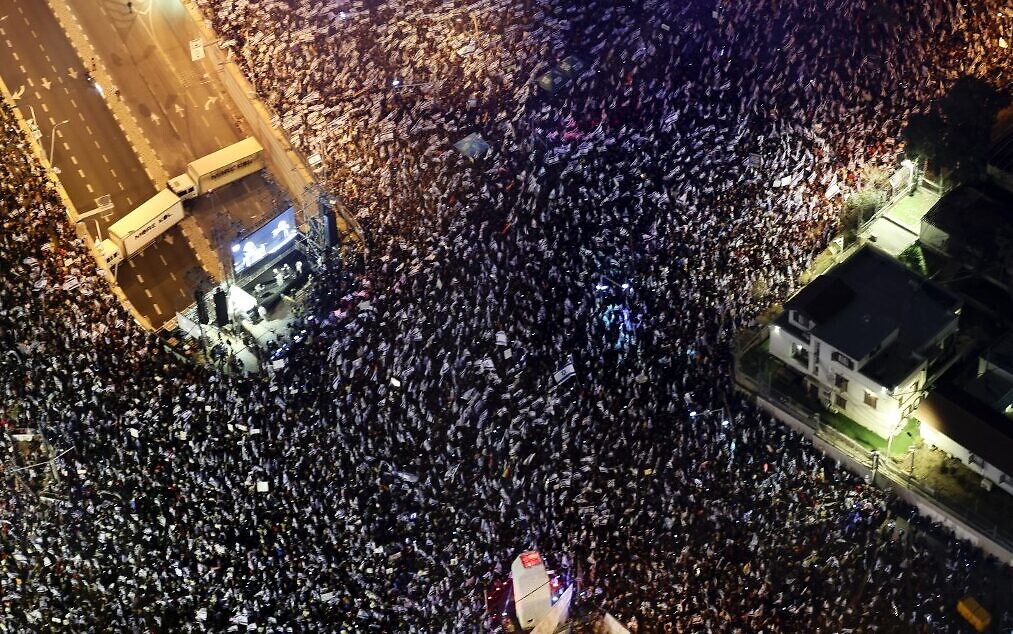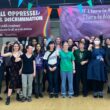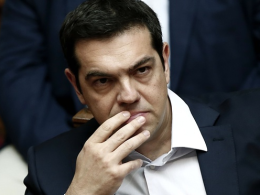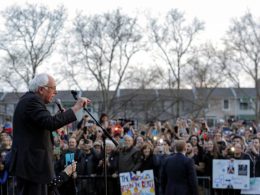By Shahar Ben Horin & Yasha Marmer, Socialist Struggle (our sister organisation in Israel/Palestine)
Since the first week of January, Israeli capitalism has been gripped by an escalating historic political crisis, involving an unprecedented mass movement against the ‘judicial coup’, along with a mobilization of the ruling class against the government. An “illegal” general strike is organized today, 27 March (Monday).
This follows the return to power of a weakened Netanyahu, in an alliance with the Jewish ultra-orthodox and the far-right. It is the sharpest political confrontation in the history of the State of Israel, touching on the foundations of the system of governance over the “official” population, where a type of (discriminatory) bourgeois democracy exists, in parallel to the variants of police and military control over the Palestinian population in the territories of ‘67.
These are the final days of the winter session of the Knesset, the Israeli parliament. The new Netanyahu government is in a partial retreat and openly split around its attempted ‘judicial coup’. This attempted power grab, an element of a ‘coup from above’, employing a 4-seat majority in the Knesset, by a government elected on less than 50% of the votes, has initially attempted a legislation blitz of several bills as a judicial counter-reform. In essence, alongside other reactionary legislation, it aims to tighten government control over the judiciary, and specifically the ‘High Court of Justice’ (Bagatz, name of the Supreme Court when it assumes the role of a quasi-constitutional court). It would shift the Israeli political regime in a more authoritarian, Bonapartist direction.
However, the unpopular weak government underestimated the potential for a counter-movement. It ignited a persistent Israeli mass movement alongside an unprecedented opposition from the capitalist ruling class and state apparatus. It has come to the edge of a ‘constitutional crisis’ in the form of a possible stand off between the government and the Supreme Court. The latter may overrule government-led legislation as ‘unconstitutional’ and then in turn be overridden by the government. That would open up the prospect of the state apparatus, including the armed forces, even moving to stand by the Supreme Court and not by the government. Under pressure, Netanyahu’s government now implies that it would allegedly abide by any Bagatz decision on its planned legislation. For some in the government, this seems like a safe ladder to step down from this crisis and stabilize the government. But in itself this may tear apart the ruling coalition, as it would be deemed an unacceptable retreat by the Judicial Minister and other hawkish elements around this move, who expect to exploit their opportunity in power to its fullest.
Netanyahu’s 6th government has also been subject to mounting pressures from US imperialism and its regional allies. Those particularly fear the consequences of its zealous drive to fortify the military occupation and colonial settlements, not least via bloody raids at the heart of the West Bank. It triggered several popular Palestinian protest strikes and demonstrations, against the backdrop of a rising death toll, with about 90 Palestinians who were killed by the Israeli occupation forces in the West Bank and East Jerusalem since the start of 2023.
Meanwhile, a rise to 14 in the number of Israelis killed in the national conflict, did not cut across the Israeli mass movement. Moreover, Israeli cops who were sent to repress (water cannons, stun grenades, arrests) Israeli protesters were met with a repeating popular call: “Where have you been during Huwara?!”, in reference to the Israeli far-right settlers’ pogrom-type onslaught on the Palestinian town Ḥuwara (حوّارة) in the West Bank on 26 February. This sentiment developed despite the hijacking of the leadership of the movement by finance capital, former military generals and establishment ‘center’ parties, who infused the movement with an utterly reactionary element of a “patriotism contest” versus the Israeli government. It includes the deliberate organized flooding of protests with Israeli flags to an extent that would have been associated prior with the events of the colonial settlers’ movement. They also incited against the presence of Palestinian flags in protests. At one incident, a Socialist Struggle (ISA in Israel-Palestine) member was assaulted by a ‘center’ supporter because our members have been intervening with a cross-community working-class program for the expansion of the fight ‘for democracy’, against the rule of capital and against the occupation, while defending protesters who waved Palestinian flags against attacks.
Occupation regime in a deepening crisis
The Biden administration openly called the Netanyahu government to halt its judicial counter-reform and restrain provocative actions against the Palestinians. In January, Biden launched an airlift of visits to Israel by US’s State Secretary Blinken, National Security Advisor Sullivan, and Director of the CIA Burns. These, reportedly, offered Netanyahu a deal: halting of the judicial counter-reform, keeping the status-quo in Al-Haram Al-Sharif/Temple Mount (the Al Aqsa Mosque compound), and restraining settlements activity, in exchange for increased collaboration over measures against Iran, and over Israeli-Saudi normalization. US ambassador to Israel, Nides, confirmed this line. To no avail. After the Israeli declaration of extensive construction in the colonial settlements and official legalization of 9 formerly illegal settlement “outposts” — a significant move of crawling annexation — the US signed a flaccid denunciation by the UN ‘Security Council’. But this was instead of a formal vote over an open denunciation resolution proposed by the UAE, which in 2020 had been at the forefront of normalizing its relations with Israeli capitalism.
Two emergency summits were convened in Aqaba (26 February) and Sharm El-Sheikh (19 March), with envoys of the US, Egypt, Jordan, and a dragged Palestinian Authority, pressurizing direct representatives of Netanyahu — not of his government — and the Israeli state’s security apparatus.
The Aqaba summit materialized as a major farce within hours. The representatives of Netanyahu committed for a cynical, hollow, 4-months freeze in new colonial settlement construction (excluding the aforementioned extensive construction approved), only to see how the far-right Israeli Minister of Treasure and Settlements, Bezalel Smotrich, tweets that nothing of the sort will happen. Following the Israeli far-right settlers’ rampage in Huwara that evening, he stated that “the Huwara village should be erased, I think that the State of Israel should do it”. In response, his visit to the US was boycotted by the Biden administration, which despite its decisive practical aid to the oppression of millions of Palestinians cannot allow itself explicit association with such elements. That bare statement, taking the logic of Zionist chauvinism to its final conclusion, nevertheless, accelerated a wave of threats by Israeli military pilots and elite units to refuse service, adding to the crisis of legitimacy of the Israeli government. A similar trend may potentially develop among a section of ordinary rank reservists, even in a scenario of a military escalation.
The Sharm El-Sheikh summit, a moment before the beginning of the Ramadan (23 March), ended with a repetition of the 4-months freeze token ‘commitment’. Smotrich, who was forced to rhetorically retreat from his previous comments regarding Huwara, didn’t openly reject that measure. Instead, he gave a speech at a Paris conference on a podium which was bearing a map of a maximalist version of the ‘Greater Israel’, incorporating historic Palestine and contemporary Jordan, and declared that “there is no such thing as a Palestinian people… This truth should be heard here in the Élysée, it should be heard also by the Jewish people in the State of Israel that got a bit confused, and this truth should be heard at the White House in Washington ”. Formal international denunciations flowed from the US, EU, China, Jordan, Egypt, UAE, as well as Saudi Arabia. The Jordanian parliament, during a session featuring a map with the Jordanian flag incorporating also historic Palestine, voted to expel the Israeli ambassador. The Saudi monarchy tuned up its rhetoric to “denounce the racist statements of one of the top officials of the Israeli occupation government against the Palestinian people“. Merely a day passed from the speech, and the Israeli government-controlled Knesset passed a bill allowing settlers to go back to areas in the northern West Bank that were ”evacuated” in 2005.
Further complicating the situation, the Saudi-Iranian negotiations culminated in a detente and restoration of diplomatic relations, declared in Beijing — a step up in Chinese imperialism’s regional role. That deal is meant to be followed by a Beijing summit of Iran with the Gulf Cooperation Council (GCC). Although Washington preceded it with new sanctions on firms, including in China, that facilitate Iranian fossil fuel export, this new shift in regional relations is burying deeper the former Iranian “nuclear deal” (JCPOA) and further dismantling the “anti-Iranian front” in the region, sought by Israeli imperialism under US imperialist sponsorship. It would complicate the Israeli regime’s geostrategic strive for normalization with Saudi Arabia and a potential attempt at an Israeli military attack against Iranian nuclear facilities.
The trajectory marked by the current Israeli government further whips up popular opinion internationally against the Israeli occupation. A Gallup poll (16 March) indicated that for the first time in this century, US supporters of the Democratic Party, after a decade of declining sympathies towards Israel, have shifted to sympathize with the Palestinians. This process further feeds a relative undermining of US imperialist backing for the Israeli regime. It is one illustration of how Netanyahu’s ruling coalition with the far-right, born as a result of a systemic crisis, is a chaos agent for Israeli capitalism. A Palestinian prisoners’ hunger strike was planned to be launched by a prisoners’ committee at the start of the Ramadan, after the far-right Minister of ‘National Security’ Ben-Gvir dictated a worsening of their imprisonment conditions, but is currently on a halt, following concessions by a fearful Israel Prison Service.
The Israeli ‘Institue for National Security Studies’ (INSS) issued an exceptional “Strategic Alert”, demanding the Israeli government halts its judicial counter-reform, which they regard as hindering the state’s coping with “an ominous combination of severe threats to its national security, widening rifts in its relations with the US, and increasing economic risks amid the global economic crisis”. Earlier, the secretary-general of the right-wing Islamist populist Hezbollah in Lebanon, Nasrallah, ridiculed the crisis of the Israeli regime, saying that “the strategic environment and the current foolish government are pushing matters into two major clashes, the first internally in Israel and the second with the Palestinians, and it may extend throughout the region“. In what has been speculated as a joint venture by Hezbollah and Hamas, an infiltrator from Lebanon planted a bomb in the north of Israel, wounding a Palestinian citizen of Israel (13 March). Within days, meetings were held by Nasrallah and leaders of Palestinian Islamic Jihad (PIJ) and of Hamas, whereas a PIJ commander in Syria was assassinated, seemingly by the Mossad.
Once again, the Israeli stepped up state-terrorist measures against the Palestinians in the West Bank and East Jerusalem may end up in a flare up of both popular resistance and military confrontations around the Ramadan period, not least a major Israeli military offensive, as demonstrated in May ‘21. Adding to pressures are also pending threats of an ethnic cleansing of 12 villages in Masafer Yatta in the West Bank, approved by the Israeli ‘High Court of Justice’, and evictions in Sheikh Jarah. The Israeli military has pivoted tactically to attempt pressing some breaks with cynical, meagre civilian relief measures for part of the Palestinian population under the military occupation and siege in the territories of ‘67. Yet, this pales next to the jingoist saliva of elements in the current Israeli government thirsty to trigger a major nationalist confrontation and a ‘security’ conflagration, which may as well cut across, in a way, the Israeli mass movement. Provocations around the Al-Aqsa Mosque, or vicious exploitation of isolated incidents of individual terrorist attacks against Israeli civilians to launch military or far-right settlers’ actions, may explode a powder-keg.
An increase in the rate of indiscriminate rockets fired by PIJ from the besieged Gaza this year imply the potential of a multi-arena military escalation. Nevertheless, the relative surge in Palestinian popular mobilizations for protest strikes and demonstrations against the occupation, as well as enhanced organized workers’ action, including the recent Palestinian teachers’ strike, and Palestinian youths seeking methods for defence in struggle, all reflect the building up of concrete potential for semi-mass and even mass struggle against the occupation.
Israeli ruling class opposition
Netanyahu’s 6th government attempted judicial power grab has its parallels in judicial counter-reforms used in various countries since the last decade to concentrate more power in government, transforming political regimes in a Bonapartist direction. However, in their strive to concentrate power, Netanyahu and his government are an antithesis to the “strong leader” and “strong government” models that Erdoğan, Orban, Putin, or the Polish PiS, were presenting at the height of their power. Unlike those, Netanyahu doesn’t have any significant wing of the capitalist ruling class behind him. In fact, he’s been openly opposed in an unprecedented way by capital, the state apparatus and the military-security elite.
The president of the Supreme Court publicly lashed out against the government’s agenda. The state’s Attorney General defyingly challenges the juridical basis for several of the government’s moves, infuriating ministers, including frustrating an attempt by the ‘National Security’ Minister Ben-Gvir to sack the Tel Aviv region’s police chief as a sanction for allegedly not cracking down harder on demonstrations. In the Mossad and military, upon pressure, it was declared that all except high-ranked officers may participate in the movement against the ‘judicial coup’.
The capitalists’ main associations openly demanded that the government withdraw its judicial measures. Hitech corporations threatened with capital flight, which a few dozens implemented on a limited scale, with several billions of USD estimated to have been transferred abroad. This partially affects also the weakening of the Shekel versus USD, which drives up the costs of import at a time of a costs of living crisis.
The hitech sector constitutes the bulk of Israeli export and about 15% of GDP, a feature which served for the capitalist branding of Israeli capitalism as a “start-up nation”. Now, the political conflict is a catalyst in an economic slowdown, fed by a slowdown in global hitech and economy. Although Israeli banks collected last year a record net profit of over 22 billion shekel as a result of rising interest rates, and are not as deregulated and exposed as their US counterparts, their tycoon owners also openly oppose the Israeli government’s judicial plan, worried over broad implications for finance capital in Israel, with potential degrading by rating agencies, decline in foreign investments, and a recession scenario. Governor of the central bank warned that an economic crisis could break out at any moment. Big capitalists held meetings with Netanyahu and top politicians of the Likud to warn against the judicial plan’s implications. This, along with pressures from within the military, and from a questioning and deflating electoral base, have sharpened divisions at the top of the Likud, with some pressing to freeze legislation. Security Minister Galant, a senior Likud member, called to halt the legislative process, and was sacked by Netanyahu, in an attempt to move ahead with legislation, which only spilled more gasoline into the fire.
State President Herzog intervened earlier to propose a “compromise”, promptly rejected by the government, but rallied support from the ruling class. His program outline was an attempt at a stabilizing route for Israeli capitalism out of the acute political crisis. It incorporated elements from the government’s program, of strengthening government over the judiciary, alongside setting a more complex procedure for the legislation of the ‘Basic Laws’, which are regarded as a quasi-constitution in the making.
Of course, these upholders of the dictatorship of capital, and dictatorship of the occupation, are not motivated by defending the democratic rights of the working class and oppressed. They’re concerned particularly with the idea that more power would be concentrated at the hands of the petty-bourgeois right-wing populist and far-right political forces currently at the wheel of government.
From the ‘constitutional revolution’ to the ‘judicial coup’
Historically, the more that the Israeli political regime destabilized, the more that Bagatz moved to take on itself a larger role as a regulator of the political and legislative processes. This evolved primarily since the 1980’s, in the settings of the aftermath of the fall of the hegemony of the ‘Labor’ party, the rise of the neo-liberal counter-revolution, the development of working-class resistance, hyper-inflation, the devastating Lebanon War of 1982 and its anti-war movement, the upsurge of the neo-fascist Kahanist movement, and finally the Palestinian uprising of the 1st Intifada. Bagatz, of course, has never been a progressive stronghold, as it is fundamentally an apparatus to maintain the laws of capitalism and Zionist chauvinism. Despite allowing from time to time a certain restraint on government, again and again it served as a rubber stamp for brutal attacks against the working class and oppressed, and to whitewash crimes of the occupation and expropriation of the Palestinian masses.
The turn of Bagatz towards ‘judicial activism’ coalesced in 1992, against the backdrop of deepening political crisis, with the passing in the Knesset of ‘Basic Law: Freedom of Employment’ and ‘Basic Law: Human Dignity and Liberty’, alongside a short-lived experiment of shifting to a direct election of Prime Minister.
The very slim civil rights ‘constitutional’ laws came after decades where no ‘charter of freedoms’ could be passed. The State of Israel has no official constitution document, as a result of the national and religious contradictions it was founded upon. Originally, after 1948 and the barbaric Nakba, and while Palestinian citizens of Israel were still under military rule, although the document of the Declaration of the State of Israel ordered that the Constituent Assembly would create a constitution, Ben-Gurion quickly led a decision against that. He claimed there’s no need for a “declaration of freedoms”, but a “bill of duties”, and was concerned that the judiciary would be used to uphold “constitutional” laws and stall government actions, then by Palestinian citizens of Israel or any minority opposition elements, on the left (‘Communist Party’) and the right (Herut, the predecessor of the Likud). The historic leader of Herut, Menachem Begin, headed a weak opposition on the right of the government, and, as opposed to the Likud’s propaganda today, demanded that the judiciary would be able to abolish legislation that violates civil rights that would be promised in the words of constitutional laws. A compromise entailed that the Knesset would legislate gradually “Basic Laws” that would be regarded as an alleged basis for a future constitution, although initially these meant merely a semantic difference with ordinary legislation.
The 1992 Basic Laws were based on a compromise of ‘liberal’ bourgeois forces with Jewish religious right parties, and they were part of an attempt to stabilize and ‘normalize’ the Israeli political regime. Although it was tactically omitted in legislation that the judiciary would be empowered to abolish “non-constitutional” legislation, this was the intended result by the main initiators from the establishment parties, including a wing of the Likud. And Bagatz intervened to assume this role since 1995, in what was declared by the Supreme Court President at the time, a ‘constitutional revolution’ — in reality an anemic reform. It annulled so far 22 bills.
That constitutional reform formally promised some legal rights, such as the right for human dignity (with 2 million citizens in poverty and millions more in dire conditions under occupation), or the right not to be imprisoned arbitrarily (while Israel is regularly imprisoning Palestinians without trial via ‘administrative detention’). But the reform also perpetuated the power of the religious courts, and for the 1st time used in legislation the formulation ‘Jewish and Democratic state’, to underline that the liberal promises would be subjected to national-religious ideological considerations, according to ruling class interests. The Basic Laws defended against harming ‘property’, essentially for the haves against the have-nots, and for a freedom of employment, essentially for employers and self-employed, but did not even nominally concede the rights to organize and strike, not to mention, of course, social, material rights.
In the ensuing years, as Bagatz moved ahead to further assert its authority, as a self-defence mechanism by Israeli capitalism against destabilization, the long campaign, by hard-right, ultra-orthodox and far-right elements, to reverse the reform and restrengthen government over Bagatz, raised its head. Following the 2005 Gaza ‘disengagement plan’, and growing social, economic and political destabilization, this has accelerated, and reached new extremes in recent years. Accepted appeals to Bagatz against some of the more blunt attacks on scapegoated minorities are then demagogically presented as obstruction of solutions to social or “security” problems, such as rulings limiting the mass imprisonment of asylum-seekers from Sudan and Eritrea. Trends of destabilization have meant that governments tended to seek more “constitutional” inventions, embedded more often in Basic Laws, such as bi-annual state budget, or, at the height of the Covid crisis and following a parliamentary deadlock, a ‘parity’ shared government. 2018, with Netanyahu already facing anti-corruption protests and shifting towards more right populist attacks on the judiciary, saw new attempts to grab power back from Bagatz. It also saw the legislation of the ’Nationality Law‘, as a ’Basic Law’, the opposite of a liberal abstract promise of civil rights, it enshrined national discrimination. Bagatz never nullified a Basic Law before, but began preparing the ground for such a scenario, challenging how ruling coalitions use Basic Laws to immune legislation from judicial review.
Lenin explained that “a democratic republic is the best possible political shell for capitalism” (State and Revolution), as it allows the highest degree of system flexibility. To the extent that any such variant is controllable enough by ruling class interests, it would likely be preferred by capital. However, it is exactly the undermining of bourgeois control over the political processes in this era that has propelled ‘democratic’ regimes in a Bonapartist direction to a greater extent since the last decade. While the Israeli ruling class opposes the power grab by Netanyahu’s current government, various spokespersons of ruling class circles have made it clear that they would prefer the current political crisis to end in a ‘compromise’, along the lines of the State President’s outline, that in strive for stabilization would include elements that would strengthen the government while making the Basic Laws more rigid.
Right-wing populism is feeding upon mass distrust in the judiciary. Confidence in the Supreme Court is estimated at 42% among Jewish and 39% among Arab citizens, although the confidence rating for the government, the Knesset and political parties are even lower. The Ivory Tower judges live off very high salaries, up to 102,000 Shekels (26,000 Euro) a month for the heads of the Supreme Court and top Labor Court — currently about 19 times the Minimum Wage. The card of diversification of judges has been one phony cover in recent years of hard-right elements campaigning for strengthening the government over Bagatz. They don’t mean by this increased Arab-Palestinian representation, which stands at merely 9% of all judicial positions today, but primarily non-Ashkenazi Jews. Yet, under a millionaire corrupt Ashkenazi prime minister, this government aims to re-take over a full control of the appointment of judges, for the first time since 1953, to be able to appoint more easily conservative judges to carry through their policies, the potential repercussions of which have been exemplified in recent years in Poland, Turkey or the US. A genuine reform in the judiciary, in the interests of the working class and oppressed of all communities, would need to be radical, and obviously not about strengthening a reactionary government, nor merely about ‘diversification’.
It’s vital to oppose the dangerous ‘judicial coup’, but also to warn that no matter what the relation of forces between the judiciary and government, the former, as the judicial arm of the capitalist state, in charge of interpreting generally government-led legislation, by a selected elite, is never fundamentally independent from the government. Marx noted how in the Paris Commune revolution of 1871, “The judicial functionaries were to be divested of that sham independence which had but served to mask their abject subserviency to all succeeding governments to which, in turn, they had taken, and broken, the oaths of allegiance. Like the rest of public servants, magistrates and judges were to be elective, responsible, and revocable.” (‘The Civil War in France’).
Parallel to the military courts imposed over Palestinians in the context of judicial apartheid under military occupation in the West Bank, the Israeli civilian courts lack elementary democratic components such as a right to a jury or even limited popular election of judges. Of course, under capitalism, the ruling class employs its concentrated social force to deform all democratic mechanisms in society. Lenin noted how systemic sorting of jurors at his time meant that “because of the exclusion of workers, most of the jurors are often particularly reactionary petty bourgeois. This evil should be remedied by developing democracy to its consistent and integral form, and not by basely repudiating democracy” (1912).
A basic outline to indicate how an alternative, genuine Israeli judicial reform, in the interests of the working class, could look generally like the following:
- Stop the Netanyahu-Levin plan. No to the hijacking of power to narrow democratic freedoms, no to an authoritarian regime. Fight for the expansion of the democratic space and for a profound change in the reality of life for the benefit of the working public and discriminated communities.
- An end to the overload and procrastination in the courts. The addition of administrative, sanitation workers and judges on a living wage as a basis. Investment in infrastructure and technology. Adequate public funding, including via the increase in court fees on large corporations and a levy on large law firms.
- A more equal judicial process. Promoting suited training and democratic oversight over the police, the State Attorney’s Office, the courts, and the Prison Service for a fairer, more accountable process, as part of combating class biases against working and poor people, and sexist, racist, or anti-LGBTQ+ prejudices. Establishment of a tribunal for sexual offenses.
- Democratic judicial rights. Applying the (inexistent) democratic right to a jury in Israeli courts — ensuring a cross-community, gender equal, and mixed national composition, with the possibility of a hearing for disqualification over bias. Expanding the services of the Public Defense Office and limiting attorneys’ rates. Abolish imprisonment replacement of a fine.
- Democratic election. Replace the Commission for “Election” of Judges. A substantive democratic process for election and the possibility of impeachment, such as an elective assembly, gender-equal, and representative for minorities, which would consist of delegates elected in general elections from every local authority, from organized labor, and from community rights organizations.
- Democratization in labor court. Direct democratic election of the workers’ representatives in the judicial panel, alongside the aforementioned subjecting of all judges to a democratic process of election and the possibility of impeachment. Extension of the right to strike, no to injunction orders.
- No to expand the powers of religious courts. The right to civil marriage and divorce, including same-sex couples. Separate religious courts from the state, and operate them as independent community institutions, without legal judicial powers, with independent community funding only. Guarantee freedom of religion and the separation of religion and state.
- No to an “Overriding Clause” that would allow overriding basic rights. Constitutional recognition of the right to equality, freedom of organization, expression and strike, and the right to housing, education, health, food security, and welfare. No to the protection of property rights of capital-owners at the expense of public interest. An end to the expulsion and dispossession of residents in favor of real-estate tycoons or settlers. Repeal the “Nationality Law”.
- An end to administrative detention. An end to arbitrary arrests and incarceration without trial. Protect the right of every inmate to legal representation, to know the charges against them and to a fair trial. Abolish military courts in the West Bank, an end to the dictatorship of the occupation. Yes to an independent, democratic, socialist and equal Palestinian state, with its capital in East Jerusalem, alongside a socialist, democratic Israel, which will guarantee genuine equality of rights for all, as part of the struggle for socialist change and for peace in the Middle East.
- Combating anti-social crime and inequality. A deep investment in the rehabilitation of prisoners and in Community Courts. Nationalize the banks and key resources in the economy to combat the high cost of living and poverty, and for quality jobs, proper public housing, and health and mental support services, along welfare, education, and leisure. Transition to a socialist economy infrastructured over democratic planning, to eradicate inequality and the rule of capital, and for the well-being of all.
Centrality of the idea of a general strike
In this cross-class movement, finance capital, alongside state apparatus and the military-security elite, has intervened forcefully, in an exceptional manner, to lean on harnessing a mass struggle and on economic disruptions, with elements of partial strike of capital combined with some appeals for workers’ strike. This included pressure on the General Histadrut, the ultra-centralist main organized labor organization, to mobilize. The Histadrut right-wing bureaucracy refused up to the current escalation in the 13th week of the movement.
This is not only the ruling class acting to mobilize sections of the working class and middle layers to its own aims, but also a strong impulse at a mass mobilization from below in the most extensive and durable Israeli mass movement to date. As an indication of mobilization from below, protest groupings sprang up of not only relatively well-off hitech employees and medical doctors, but also social workers, nurses, and teachers. Some trade-unionists have spoken against the ‘judicial coup’. The relatively small but important independent democratic union federation ‘Power to the Workers’, although not openly taking a stance against that plan, has voted in its delegation assembly to launch a campaign against the threats by far-right elements in the government on the right to strike.
In a country where “political strikes” are forbidden even by the rulings of Bagatz itself, the idea of employing a labor strike as a means in the current political struggle has been central to the movement. The idea of a strike in general has echoes in the mass coordinated road-blockings in days of action — one of these forced Netanyahu to be brought in a helicopter to a besieged airport on his way to visit the far-right Italian government — and among groupings of students. It has even been reflected in the petty-bourgeois nationalist disobedience of reserve elite officers in the military, and with military industry workers who turned to block entrance to their factory. Although that in itself is not progressive when it is not linked to opposition to the occupation and policies carried by Israeli capitalism’s war machine, it is an indication of the depth of the crisis of legitimacy of the current government, and of potential for future developments of a more popular and widespread form in the context of more advanced political struggles.
While a section of the capitalists are more cautious than explicitly supporting a general strike, in general, the bourgeoisie was desperately pressed to pose the idea itself. That is not only an indication of their confidence in the right-wing leadership of the Histadrut, but also a short-sighted fueling of a sense of the power of mass struggle and ultimately a pointing towards the might of the working class, undermining of their own future attacks against “political strikes”. Initially, bypassing the Histadrut bureaucracy, days of limited protest strikes, along the lines of a “people’s strike” individual-based model, were organized. Now an organized labor unauthorized general strike is immediately posed.
This defensive political mass struggle is mobilizing primarily on the basis of an urge to obstruct a more authoritarian regime and a nationalist-religious reaction, that would involve attacks on women and LGBTQ+, religious coercion and more blunt racism. Pride flags, feminist placards, and a performance art on the basis of The Handmaid’s Tale television series, have underlined these sentiments. Those are present in the movement alongside, of course, more conservative, older middle strata, supporters of the ‘political center’. Although class antagonism has been pushed back to an extent when compared with the offensive mass movement on the costs of living in 2011, it has in some terms developed on a higher level, with less naivety towards the government and with the leap in understanding of the potential of the weapon of labor strike. Protests swelled and developed not only in the Tel Aviv metropolis and the mobilizations in Jerusalem, but also in the other main cities, including large protests in Haifa and Be`er Sheva, where there’s been a bit more of a space for left elements to intervene, involving, exceptionally and not without counter-pressures, speakers who are Palestinian citizens of Israel who spoke against the occupation and national oppression.
The criminal shirking for so long by the right-wing Histadrut leadership — unfortunately with the leftist Hadash/AlJabha (CP front) even now hanging on to it — has weakened the movement. Although no deadlock was yet reached, the government hasn’t yet been defeated, and the bourgeoisie had a relatively free hand in dictating its own agenda in the movement. The Histadrut chairperson even claimed in a speech with the Minister of Transport, that the government doesn’t pose any threat to workers, just before he concluded a very weak wage agreement in the public sector. Earlier, the Histadrut leadership even put on ice its anemic campaign against the high costs of living, at a height of a crisis of a costs of living, exacerbated by the rising interest rates — where 22% of the citizens were reportedly forced in the last year to give up medications and essential food; 44% gave up medical services; and among the Arab-Palestinian citizens, 77% gave up medical products or services. A leadership that would have intervened with a highlight of this burning problem, exposing the government and giant corporations, while mobilizing against the threats posed by the government’s proposed legislation, could have brought to the fore of the movement a working-class based agenda, and accelerated the spread of the movement and retreat of government. Instead, in a reactionary ‘divide and rule’ move, bourgeois elements at the head of the movement have turned more fire towards the poor Haredi (religious ultra-orthodox) population.
The weak government is currently in retreat, and may potentially be defeated. Although the last election was in November, and was the 5th since 2019, in the face of Netanyahu’s unabated move, there’s now a growing sentiment turning towards a general struggle against the legitimacy of Netanyahu and his government. In any case, divisions at the top of the ruling coalition emphasize it may fall apart “from within”. This arch-reactionary government is a political heritage from the previous, extraordinary capitalist coalition government of the status-quo under Lapid and Bennet, which named itself the ‘Government of Change’. In its defense of capitalism and the occupation it opened the road for the return to power of Netanyahu with a resurgent far-right. This is a warning sign that in the present movement the idea of a cross-community working-class political alternative, on a socialist program, must be put forward, to the government as well as to the unpopular pro-capitalist establishment parties of the ‘center’.












